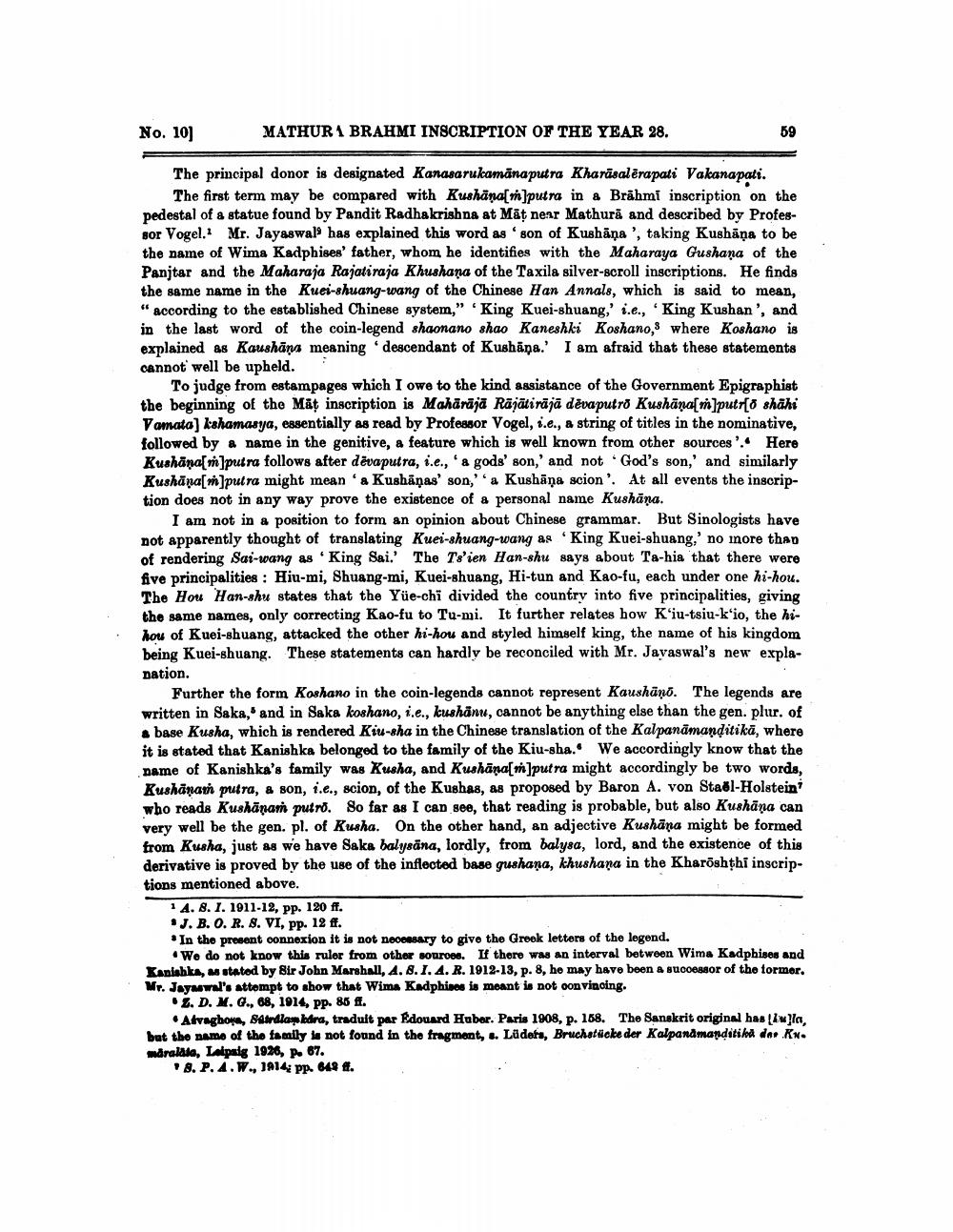________________
No. 10)
MATHURA BRAHMI INSCRIPTION OF THE YEAR 28.
=
The principal donor is designated Kanasarukamānaputra Kharāsalērapati Vakanapati.
The first term may be compared with Kushānal putra in a Brāhmi inscription on the pedestal of a statue found by Pandit Radhakrishna at Māt near Mathurā and described by Professor Vogel. Mr. Jayaswal' has explained this word as 'son of Kushāņa', taking Kushāņa to be the name of Wima Kadphises' father, whom he identifies with the Maharaya Gushaņa of the Panjtar and the Maharaja Rajatiraja Khushana of the Taxila silver-scroll inscriptions. He finds the same name in the Kuei-shuang-wang of the Chinese Han Annals, which is said to mean, "according to the established Chinese system," King Kuei-shuang,' i.e., King Kushan', and in the last word of the coin-legend shaonano shao Kaneshki Koshano, where Koshano is explained as Kaushana meaning descendant of Kushāna. I am afraid that these statements cannot well be upheld.
To judge from estampages which I owe to the kind assistance of the Government Epigraphist the beginning of the Mat inscription is Mahārājā Rājātirajā dēva putro Kushānal putro shahi Vamata) kshamasya, essentially as read by Professor Vogel, i.e., a string of titles in the nominative, followed by a name in the genitive, a feature which is well known from other sources'. Here Kushāna[m]putra follows after dēvaputra, i.e., '& gods' son,' and not God's son,' and similarly Kushāna[m]putra might mean 'a Kushāņas' son'a Kushāņa scion'. At all events the inscription does not in any way prove the existence of a personal name Kushäna.
I am not in a position to form an opinion about Chinese grammar. But Sinologists have not apparently thought of translating Kuei-shuang-wang as 'King Kuei-shuang,' no inore than of rendering Sai-wang as King Sai.' The Ts'ien Han-shu says about Ta-hia that there were five principalities : Hiu-mi, Shuang-mi, Kuei-shuang, Hi-tun and Kao-fu, each under one hi-hou. The Hou Han-shu states that the Yüe-chi divided the country into five principalities, giving the same names, only correcting Kao-fu to Tu-mi. It further relates how K'iu-tsiu-k'io, the hihou of Kuei-shuang, attacked the other hi-hou and styled himself king, the name of his kingdom being Kuei-shuang. These statements can hardly be reconciled with Mr. Javaswal's new explanation.
Further the form Koshano in the coin-legends cannot represent Kaushāno. The legends are written in Saka," and in Saka koshano, i.e., kushānu, cannot be anything else than the gen. plur. of a base Kusha, which is rendered Kiu-sha in the Chinese translation of the Kalpanāmanditikā, where it is stated that Kanishka belonged to the family of the Kiu-sha.“ We accordingly know that the name of Kanishka's family was Kusha, and Kushāna[m]putra might accordingly be two words, Kushana putra, a son, i.e., scion, of the Kushas, as proposed by Baron A. von Staðl-Holstein who reads Kushānam putro. So far as I can see, that reading is probable, but also Kushäna can very well be the gen. pl. of Kusha. On the other hand, an adjective Kushāna might be formed from Kusha, just as we have Saka balyeāna, lordly, from balysa, lord, and the existence of this derivative is proved by the use of the inflected base gushana, khushana in the Kharoshthi inscriptions mentioned above.
14. 8. 1. 1911-12, pp. 120 ff. .J.B.O.R.S. VI, pp. 12 ff. • In the present oonnexion it is not necessary to give the Greek letters of the legend.
• Wo do not know this rulor from other sources. If there was an interval between Wima Kadpbises and Kanishka, mstatod by Sir John Marshall, A. 8. 1. A. R. 1912-13, p. 8, he may have been a successor of the former, Mr. Jaymwul's attempt to show that Wima Kadphises is meant is not oon vigoing.
.Z.D. M. G., 68, 1914, pp. 86 ff.
• Atraghoya, Sirdlam bdra, traduit par Edouard Huber. Paris 1908, p. 168. The Sanskrit original has Llula, but the name of the family is not found in the fragment, .. Lüders, Bruchaticke der Kalpandmanditii dar Kn. maraldia, Laipaig 1926, p. 67.
8. P. A.W., 1914, pp. 648 ft.




